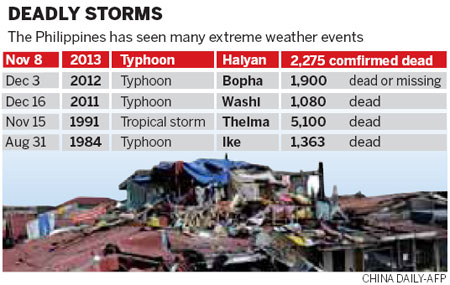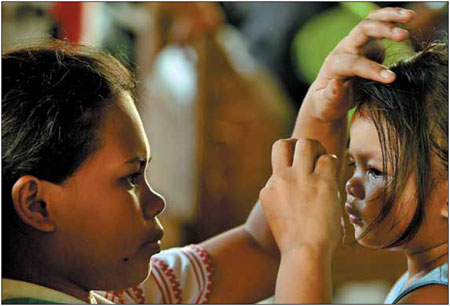Deadly looting in Philippines
Anger, frustration boil over as relief efforts lag and supplies dwindle
Desperation gripped Philippine islands devastated by Typhoon Haiyan as looting turned deadly on Wednesday and survivors panicked over delays in supplies of food, water and medicine. Some resorted to digging up underground water pipes and smashing them open.
Five days after one of the strongest storms ever recorded slammed into cities and towns in the central Philippines, anger and frustration spiked on Wednesday as essential supplies became scarce. Some survivors scrawled signs reading, "Help us".
Controversy has emerged over the death toll. President Benigno Aquino said local officials had overstated the loss of life, saying it was closer to 2,000 or 2,500 than the 10,000 previously estimated. His comments, however, drew skepticism from some aid workers.
Some areas appeared to teeter near anarchy. ANC Television said security forces exchanged fire with armed men amid widespread looting of shops and warehouses for food, water and other supplies in the village of Abucay, part of worst-hit Tacloban in Leyte province.

Military officials were unable to immediately confirm the fighting.
Eight people were crushed to death when looters raided rice stockpiles in a government warehouse in the town of Alangalang, causing a wall to collapse, local authorities said.
Thousands of people stormed the rice warehouse, highlighting the urgent need to get water, food and medical supplies into the increasingly desperate region.
"There's a bit of a logjam, to be absolutely honest, getting stuff in here," said Sebastian Rhodes Stampa, from the United Nations Office for the Coordination of Humanitarian Affairs.
Other looters still managed to cart away 33,000 bags of rice weighing 50 kg each, said Orlan Calayag, administrator of the state-run grain agency National Food Authority.
Warehouses owned by food and beverage company Universal Robina Corp and drug company United Laboratories were ransacked in the storm-ravaged town of Palo in Leyte, along with a rice mill in Jaro, said Alfred Li, head of the Leyte Chamber of Commerce and Industry.
Tacloban city administrator Tecson John Lim said 90 percent of the coastal city of 220,000 people had been destroyed, with only 20 percent of residents receiving aid. Houses were now being looted because warehouses were empty, he said.
"The looting is not criminality. It is self-preservation," Lim said.
Some survivors in Tacloban dug up water pipes in a desperate bid for water.
"We sourced our water from an underground pipe that we have smashed. We don't know if it's safe. We need to boil it. But at least we have something," said Christopher Dorano, 38.
Reuters-AP
|
A mother wipes the face of her daughter as they wait for a military plane out of Tacloban, Leyte province, central Philippines on Wednesday. Noel Celis / Agence France-Presse |

(China Daily 11/14/2013 page12)









